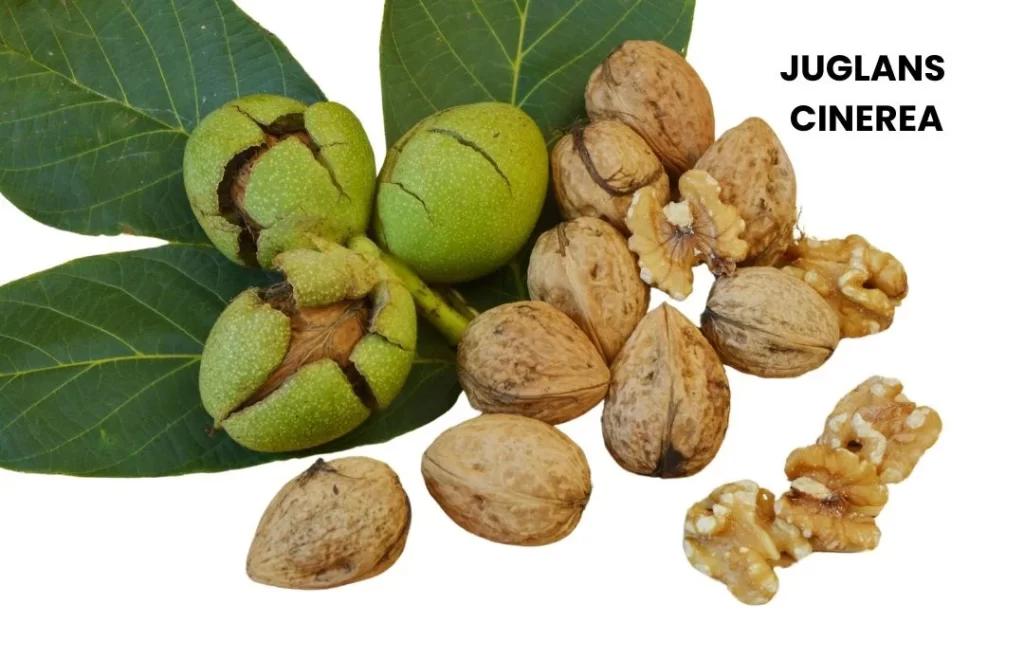Juglans Cinerea, commonly known as Butternut, is a homeopathic remedy derived from the bark of the Butternut tree.
It is renowned for its ability to address conditions arising from faulty elimination processes, leading to symptoms such as jaundice and various skin eruptions.
This remedy is also characterized by its effectiveness in treating sharp occipital headaches often associated with liver disturbances, as well as a range of other symptoms affecting the gastrointestinal and musculoskeletal systems.

SOURCE INFORMATION
Scientific Classification
- Family: Juglandaceae
- Genus: Juglans
- Species: J. cinerea
Origin
Juglans Cinerea is native to North America, particularly the eastern United States and Canada.
The Butternut tree grows in rich, moist soils of hardwood forests and is recognizable by its gray bark and compound leaves.
Historical Facts
- Traditional Use: Indigenous peoples of North America have long used the Butternut tree for its medicinal properties. The bark, in particular, was employed as a laxative and for treating liver and digestive disorders.
- Introduction to Homeopathy: The use of Juglans Cinerea in homeopathy dates back to the 19th century.
- It was introduced for its ability to address liver-related issues, skin eruptions, and gastrointestinal disturbances.
DRUG PATHOGENESIS
Juglans Cinerea primarily acts on the liver, gastrointestinal system, and skin.
It helps in the regulation of bile secretion, alleviating jaundice, and treating skin conditions resulting from poor elimination of toxins.
The remedy also addresses sharp headaches associated with liver dysfunction and various musculoskeletal pains.
KEY CHARACTERISTICS
FAULTY ELIMINATION
- Leads to jaundice and various skin eruptions.
HEAD
- Dull, full sensation in the head.
- Sharp, occipital headaches typically linked to liver disturbances.
- Sensation of head enlargement.
- Pustules on the eyelids and around the eyes.
NOSE
- Tingling sensation in the nose.
- Sneezing.
- Coryza (inflammation of the nasal mucous membrane) with thick, copious mucous discharge, preceded by pain under the sternum and a feeling of suffocation.
MOUTH AND THROAT
- Acrid feeling in the mouth and throat.
- Soreness in the tonsil region externally.
- Dryness of the root of the tongue and throat (fauces).
STOMACH AND ABDOMEN
- Atonic dyspepsia (weak digestion) with excessive eructation (belching) and flatulent distention.
- Soreness in the liver region.
BACK AND EXTREMITIES
- Rigid, lame muscles in the neck.
- Pain between the scapulae and under the right scapula.
- Pain in the lumbar vertebrae.
SKIN
- Redness resembling scarlatina (scarlet fever).
- Jaundice with pain around the liver and right scapula.
- Itching and pricking sensation when heated.
- Pustules and eczema, particularly on the lower extremities, sacrum, and hands.
- Erythema (skin redness) and erysipelatous redness (similar to erysipelas, a bacterial skin infection).
STOOL
- Yellowish-green stools with tenesmus (painful straining) and burning at the anus.
- Camp diarrhea (diarrhea occurring in camping or travel situations).
MODALITIES
Better
- Getting heated.
- Exercise.
- Scratching.
- Rising in the morning.
Worse
- Walking.
WHAT ARE MODALITIES IN HOMOEOPATHY?
RELATIONSHIP WITH OTHER DRUGS
Compare
- Juglandin: Useful for duodenal catarrh (inflammation of the duodenum) and bilious diarrhea.
- Chelidonium: Known for treating liver and gallbladder conditions.
- Bryonia: Effective for various inflammatory conditions.
- Iris: Used for gastrointestinal and liver-related ailments.
DOSE
- Form: Tincture.
- Potency: Third potency (dilution).
Frequently Asked Questions
What conditions can Juglans Cinerea treat?
- Juglans Cinerea is primarily used for treating jaundice, skin eruptions, sharp occipital headaches associated with liver issues, and gastrointestinal disturbances.
How is Juglans Cinerea administered?
- It is typically administered in tincture form or diluted to the third potency in homeopathic practice.
Are there any side effects of Juglans Cinerea?
- Side effects are generally rare when used in homeopathic doses. Some individuals may experience mild digestive disturbances or allergic reactions.
Can Juglans Cinerea be used for liver detoxification?
- Yes, Juglans Cinerea is known for its effectiveness in regulating bile secretion and aiding in liver detoxification.
Meaning of Difficult Words
- Elimination: The process of expelling waste products from the body.
- Jaundice: A medical condition characterized by yellowing of the skin and eyes due to high bilirubin levels.
- Occipital: Relating to the back part of the head or skull.
- Cholelithiasis: The formation of gallstones.
- Coryza: Inflammation of the mucous membrane in the nose, causing a runny nose.
- Acrid: Having an irritatingly strong and unpleasant taste or smell.
- Fauces: The part of the mouth at the back of the throat.
- Atonic Dyspepsia: Weak or poor digestion.
- Tenesmus: Painful straining during bowel movements.
- Scarlatina: Another term for scarlet fever.
- Erythema: Redness of the skin.
- Erysipelatous: Relating to erysipelas, a type of skin infection.
Juglans Cinerea is a valuable remedy in homeopathy, addressing a range of conditions related to liver dysfunction, skin issues, and gastrointestinal complaints.
